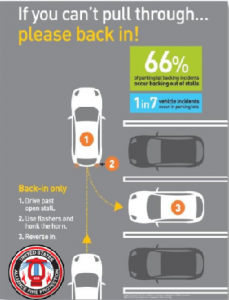WHY REVERSE PARKING OR FORWARD FIRST PARKING IS SAFER
Why is Reverse Parking or Forward First Parking safer? Continue reading for the facts, the myths and why you should do it everywhere you go!
Driver safety does not stop in the parking lot. In fact, drivers should be even more vigilant of their surroundings while operating their vehicle in a parking lot. Following parking safety strategies and reverse parking into your space could potentially save lives.
Next time you go to the grocery store, take a look around the parking lot as you walk through. You’ll likely notice that very few cars are parking forward first. In a study conducted by The National Highway Traffic Safety Administration (NHTSA), on average 76% or drivers park nose-in, the way many of us are used to parking. Forward first parking is something that may feel awkward at first, but after a few times it’ll become an easy habit. Parking this way has numerous safety advantages. At United States Alliance Fire Protection, Inc. our top priority is the safety and wellbeing of our employees. We encourage everyone to park forward facing in and out of the workplace to promote the safety and wellbeing of yourself, your team members, your family, and the community in which we work.
Did You Know…Reverse Parking Could Save a Life
Parking in reverse is a simple way to reduce the risk of accidents. The National Highway Traffic Safety Administration (NHTSA) estimates that “267 people
 are killed and 15,000 injured each year by drivers not parking forward first, usually in driveways or parking lots.” Unfortunately, most often it is children and elderly people who are killed in backover crashes.
are killed and 15,000 injured each year by drivers not parking forward first, usually in driveways or parking lots.” Unfortunately, most often it is children and elderly people who are killed in backover crashes.
By reverse parking, you avoid backing out blindly into oncoming traffic or into the path of pedestrians.
Misconceptions About Reverse Parking
Myth #1: Reverse parking disrupts traffic.
In a busy parking lot, it feels much easier and quicker to just go nose-first into the first parking stall you see and go on your way. The truth is, that time you’ll take to back in, you’ll save later when you can seamlessly drive out of the stall when leaving. Trying to back out into unknown traffic is more hazardous and difficult than backing into a clear and safe parking stall.
Myth #2: Reverse parking is less safe.
Parking lots are full of pedestrians, and therefore the probability of injury is high. Reverse parking is about making the environment safer when the driver leaves the parking space. When reverse parking, a driver is going into a known space with no vehicle and pedestrian traffic. When leaving the parking space, the driver is able to see the surroundings more clearly.
On the other hand, backing out of a parking space means going out into unknown and changing traffic. A driver’s view is further hindered by the cars parked next to it. The other cars increase the driver’s blind spots.
Parking Safety Tips:
The following strategies for safe parking have been compiled from industry and insurance studies.
-
-
- Stay alert and scan the area. Use your mirrors or rear-view cameras.
- Look for pedestrians.
- Drive slow. Obey posted speed limits and signs.
- Wear your seat belt.
- When parking, keep distance between your vehicle and others.
- Reverse park into the parking space.
-
We encourage everyone to exercise forward-first parking. Taking the time to back into a sure-safe parking stall is a small lifestyle change that could prevent an accident and could save a life.
There are certain instances where parking forward-facing does not make sense or is not allowed:
-
-
- Diagonal parking spots.
- When you have to take large or numerous cargo items out of the back of your vehicle.
- When there is signage stating you cannot park forward-facing.
-
Safety should always be the #1 priority. You could save a life, START TODAY! For all your life and fire safety needs, contact USA Fire Protection at 847-816-0050 or visit our website.
